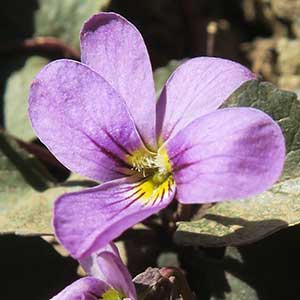Viola flettii
Viola glabella
Flett's violet, Olympic violet, rock violet
pioneer violet, smooth yellow violet, stream or smooth yellow or yellow wood or wood or smooth yellow woodland violet, stream violet, violette glabre, yellow wood violet
1–3, ascending to erect, mostly glabrous, on caudex from fleshy rhizome.
1–3, erect or prostrate, leafless proximally, leafy distally, glabrous or finely puberulent, on caudex from fleshy rhizome.
basal and cauline;
basal: 1–3;
stipules linear-lanceolate, margins entire or with glandular processes, apex acuminate;
petiole 1.5–9.7 cm, mostly glabrous;
blade purple-tinted and –veined, broadly reniform to ovate, 0.9–2.4 × 1.2–4 cm, base cordate, margins finely crenate-serrate, eciliate, apex acute to obtuse, surfaces glabrous or sparsely pubescent along veins adaxially;
cauline similar to basal except: stipules ovate to lanceolate, margins entire or shallowly laciniate;
petiole 0.7–5.9 cm, usually glabrous;
blade 0.8–2.1 × 1.2–3.1 cm.
basal and cauline;
basal: 0–4(–7);
stipules ovate to obovate, margins entire, crenate, or serrate, usually glandular, apex acute to obtuse;
petiole 7–27.5 cm, glabrous or puberulent;
blade usually reniform to ovate, sometimes orbiculate, 3.3–8.5 × 2–9.3 cm, base cordate, margins crenate to serrate, ciliate or eciliate, apex acute to obtuse, mucronulate, surfaces glabrous or finely puberulent;
cauline similar to basal except: usually restricted to distal ends of naked stems;
stipules ovate to oblong, margins erose or subserrate, often glandular, apex acute to acuminate;
petiole 0.2–2.9 cm, glabrous or finely puberulent;
blade ovate to deltate, 1.4–5.7 × 0.8–4.7 cm, base cordate to truncate, margins crenate to ± serrate, ciliate (sometimes limited to proximal half), apex acute.
1.8–7.1 cm, usually glabrous.
2–8 cm, glabrous or pubescent.
sepals lanceolate, margins eciliate, auricles 0.5–1.5 mm;
petals soft reddish violet on both surfaces, all with yellow area basally, lower 3 dark violet-veined, lateral 2 bearded, lowest with white around yellow area, 10–15 mm, spur yellow, gibbous, 0.5–2 mm;
style head bearded; cleistogamous flowers axillary.
sepals linear-lanceolate, margins eciliate, auricles 0.5–1 mm;
petals deep lemon-yellow on both surfaces, lower 3 and sometimes upper 2 brownish purple-veined, lateral 2 bearded, lowest 6–18 mm, spur yellow to greenish, gibbous, 0.5–2 mm;
style head bearded; cleistogamous flowers axillary.
± spherical, 5–9 mm, glabrous.
ovoid to ellipsoid, 7–13 mm, glabrous.
dark brown to brownish purple, 2.5–3 mm.
light to dark brown, shiny, 2–2.2 mm.
= 24.
Viola flettii
Viola glabella
Viola flettii is endemic to the Olympic Mountains of northwestern Washington. C. S. McCreary (2005) noted that although morphologically and ecologically distinct, V. cuneata, V. flettii, and V. ocellata are closely related.
(Discussion copyrighted by Flora of North America; reprinted with permission.)
Viola glabella is similar in overall appearance to V. pubescens. The cauline leaves are sometimes described as appearing only near the apex of the stem (P. A. Munz 1959), but often a leaf occurs from a node on the stem below the apex.
Viola californica was described from collections made in Humboldt and Trinity counties, California, and may have arisen as a hybrid between V. glabella and V. lobata var. integrifolia. It is apparently limited to Abies concolor forests above 1520 m (M. S. Baker 1953). Study of V. californica is needed to determine if taxonomic recognition is warranted.
(Discussion copyrighted by Flora of North America; reprinted with permission.)
- Local floras:
BC,
CA,
OR,
WA
- Local Web sites:
CalFlora,
CalPhotos,
Flora NW,
PNW Herbaria,
Turner Photog.
WildflowerSearch
iNaturalist (observations)
USDA Plants Database
- LBJ Wildflower Center
- SEINet
- Plants of the World Online
- Encyclopedia of Life
- Wikipedia
- Google Image Search


